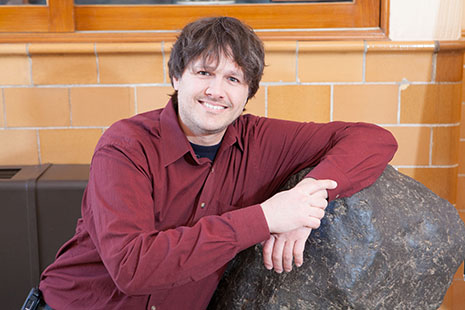
FAYETTEVILLE, Ark. – When an asteroid streaked across the sky over California and Nevada and exploded last spring, scientists from across the world rushed to the scene to recover as many pieces of the space rock as possible.
They formed the Sutter’s Mill Meteorite Consortium, named for the location of the search area in northern California. Robert Beauford, a doctoral student at the University of Arkansas, was the first member of the group to recognize that the meteorite offers a glimpse into the outermost surface of the asteroid before it fell to Earth.
“It is a regolith breccia,” Beauford said. “‘Breccia’ means a rock composed from fragments of broken rock. ‘Regolith’ refers to the outermost surface of an asteroid or dry, rocky planet. This means that the Sutter's Mill meteorite is the outermost layer, analogous to soil, of one of the most primitive classes of asteroid. It records the last 4.56 billion years of the asteroid’s interactions with the solar system and contains the excavated and mixed remnants of a variety of rock types that are contained within the asteroid.”
Beauford came to the conclusion after he examined the physical characteristics of the meteorite to decipher the rock groups preserved within it and the types of changes these rock groups underwent and the order in which they took place.
The 70 members of the consortium published the results of its study on Dec. 21 in the journal Science. The article, “Radar-Enabled Recovery of the Sutter’s Mill Meteorite, a Carbonaceous Chondrite Regolith Breccia,” describes the research conducted on the meteorite, which landed in and around Coloma, Calif., the morning of April 22, 2012. After months of searching, the team recovered 77 pieces that in total weighed just more than two pounds. The fragments were then distributed to scientists for study.
Beauford’s recognition of the nature of the meteorite was so important that it was mentioned in the title of the Science article, said Derek Sears, a former professor of chemistry and biochemistry at the University of Arkansas and a member of the consortium. A microscopic image taken by Beauford of a section of the meteorite was published by both Science and The New York Times.
“Regolith breccias are rocks from the very surface on an airless body, in this case the asteroid that the meteorite came from,” Sears said. “They are essentially rocks within rocks, or rocks mixed with ‘soil’ and then turned into a rock. What we are seeing, in the Sutter’s Mill meteorite, is the very surface of the asteroids that spacecraft will one day have to land on. So the data have implications for both science and exploration.”
The consortium concluded it is also the most pristine example yet collected of a rare type of carbonaceous chondrite.
“Carbonaceous chondrites are among the most unaltered materials from the earliest moments of formation of our sun and planets,” Beauford said. “They record the highest quantities — out of any of the meteorite classes — of some of the most delicate and rare materials known to science. These include pre-solar grains and organic carbon molecules that formed in the first moments of solar system history. Though light from distant stars can be much older, pre-solar grains are the oldest material objects that we have discovered on this planet. Some of them potentially pre-date our sun by as much as a billion years.”
Researchers at the Search for Extraterrestrial Intelligence Institute and NASA Ames Research Center, both located in Mountain View, Calif., initiated the Sutter’s Mill Meteorite Consortium. Beauford and Sears, now a meteoriticist with NASA Ames, co-edit Meteorite magazine, an international journal of meteorite science. Sears is Beauford’s doctoral adviser.
Beauford is curator of the U of A’s meteorite collection. He presented his findings related to the meteorite at the 2012 International Meteoritical Society Conference in Cairns, Australia, and in March he plans to present two more papers at the annual Lunar and Planetary Science Conference at The Woodlands, Texas, just outside Houston.
Contacts
Robert Beauford, space and planetary sciences
Arkansas Center for Space and Planetary Sciences
651-472-1621, rbeaufor@uark.edu
Chris Branam, research communcations writer/editor
University Relations
479-575-4737, cwbranam@uark.edu